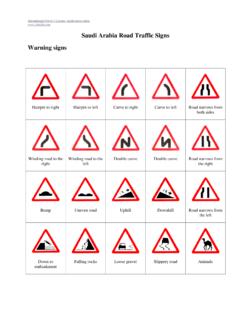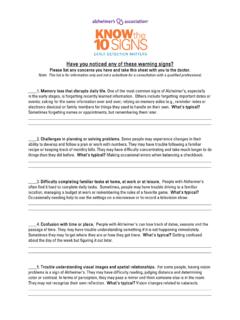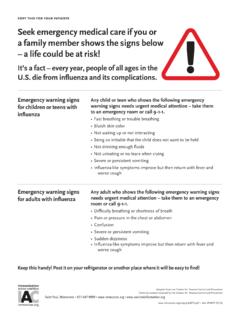Transcription of Max Birchwood, Elizabeth Spencer & Dermot McGovern
1 Schizophrenia: early warning signsAPT (2000), vol. 6, p. 93 Schizophrenia: early warning signsMax birchwood , Elizabeth Spencer & Dermot McGovernAdvances in Psychiatric Treatment (2000), vol. 6, pp. 93 101 Max birchwood is Director of the Early Intervention Service (Harry Watton House, 97 Church Lane, Aston, Birmingham B65UG) and Director of Research and Development of Northern Birmingham Mental Health NHS Trust. He is also a ResearchProfessor at the School of Psychology, University of Birmingham. Elizabeth Spencer is a senior clinical medical officer workingin Northern Birmingham Mental Health NHS Trust.
2 She has a clinical interest in the early treatment of young people withpsychosis. Dermot McGovern is a consultant psychiatrist working in Northern Birmingham Mental Health NHS Trust. He hasa clinical interest working with people with serious mental in schizophrenia remains common andcannot be entirely eliminated even by the bestcombination of biological and psychosocial inter-ventions (Linszen et al, 1998). Relapse prevention iscrucial as each relapse may result in the growth ofresidual symptoms (Shepherd et al, 1989) andaccelerating social disablement (Hogarty et al, 1991).
3 Many patients feel entrapped by their illnesses, afactor highly correlated with depression (Birchwoodet al, 1993), and have expressed a strong interest inlearning to recognise and prevent impendingpsychotic warning signsand the relapse signature The early warning signs approach to relapseprevention seeks to identify the earliest signs ofimpending psychotic relapse and to offer timely andeffective intervention to arrest their progressiontowards frank are the early warning signs of psychotic relapse?Investigations ( Herz & Melville, 1980; Birchwoodet al, 1989; J rgensen, 1998) have consistentlydetermined that subtle changes in thought, affect andbehaviour precede development of frank psychosis.
4 Dysphoric symptoms (depressed mood, with-drawal, sleep and appetite problems) are mostcommonly reported, while psychotic-like symptoms(for example, a sense of being laughed at or talkedabout) are less frequent. Furthermore, thesesymptoms generally occur in a predictable order,with non-psychotic phenomena occurring earlyin the illness, followed by increasing levelsof emotional disturbance and, finally, by thedevelopment of frankly psychotic symptoms(Docherty et al, 1978). The progression occurs, mostfrequently, over a period of less than four weeks( birchwood et al, 1989; J rgensen, 1998).
5 Although these symptoms have sometimes beenreferred to as the psychotic prodrome , they aremore accurately conceptualised as early warningsigns of psychotic relapse, since the concept of a prodrome (a term derived from the medicalliterature) implies a disease progression that cannotbe interrupted. However, investigators havefound that people with psychosis actively usecoping strategies to intervene in the onsetof psychosis (McCandless-Glimcher et al, 1986).Furthermore, strictly speaking, prodromal symp-toms of psychosis include only those non-specificsymptoms that may signal the onset of a varietyof illnesses.
6 However, attempts to predict the onsetof psychosis from non-specific or dysphoricprodromal symptoms alone have yielded poorsensitivies and/or specificities ( Jolley et al,1990), but results have been more promising whenlow-level psychotic symptoms are included in thepredictor (2000), vol. 6, p. 94 birchwood et alCan psychotic relapse be predictedaccurately from these earlywarning signs?Prospective studies (Subotnik & Neuchterlein, 1988; birchwood et al, 1989; J rgenson, 1998) have shownthat psychotic relapse can be predicted with asensitivity of 50 79% and a specificity of 75 81%when standardised measures of neurotic or dysphoric symptoms are combined with those oflow-level psychotic symptoms and ratings areconducted at least , there is considerable variability betweenindividuals in the nature and timing of their earlywarning signs ( birchwood et al, 1989)
7 , and predictionof relapse is more accurate if changes in earlywarning scores are evaluated against individuals own baseline scores rather than compared withthose of other patients (Subotnik & Neuchterlein,1988; J rgensen, 1998). Thus, to be clinically useful,methods of identifying early warning signs ofpsychotic relapse must take into account thisindividual these reasons, research attention has recentlybeen directed towards identifying and managingeach patient s relapse signature ( birchwood , 1995):his or her unique pattern of early warningsigns most likely to indicate impending psychoticrelapse.
8 Later in this article, we will present amethodology used in our clinical practice forthis patients identifytheir own early warning signs ?A large percentage of people with schizophrenia andtheir relatives are aware of these early signs ofimpending relapse (Herz & Melville, 1980). Onestudy found that 63% of patients maintained insightinto their deteriorating mental state until the day oftheir relapse (Heinrichs et al, 1985). J rgensen (1998)also found that patient self-reports of early warningsigns predicted relapse with a sensitivity and aspecificity almost equal to those derived followingthe early warning signsIn our practice, two sorts of interventionsare offered following the onset of earlywarning signs.
9 Cognitive behavioural therapy behaviouralinterventionsThe stress vulnerability model (Zubin & Spring,1977) views the symptoms of schizophrenia as theresult of environmental stressors acting on thevulnerable individual, and predicts that a reductionin stress or the acquisition of stress managementskills should decrease the chance of psychoticrelapse. The association of stressful life events(Hirsch et al, 1996) and stressful home environments(Kuipers & Bebbington, 1988) with relapse amongpeople with schizophrenia adds weight to this modeland its is evidence that even after the onset of earlywarning signs, stress management skills may behelpful in preventing psychotic relapse.
10 For example,McCandless-Glimcher et al (1986) found that manypatients with schizophrenia use cognitive behav-ioural techniques to deal with the early warningsigns of relapse without being formally instructedto do so. Furthermore, Hogarty et al (1997) foundthat treatment with an individualised and gradedapproach to stress management, particularlyfocusing on the identification and management ofaffective dysregulation preceding relapse ( personaltherapy ), was associated with a significant overalleffect in delaying adverse events (includingpsychotic or affective relapse or treatment-relatedtermination)







